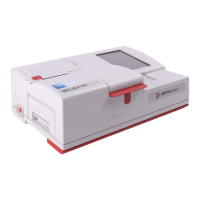Operator’s Manual – OPTI CCA-TS2 5-3
5 SAMPLE HANDLING AND PATIENT TESTING
5.1.7 Handling and Storage of Samples
Please refer to CLSI Document H18-A3, Procedures for the Handling and Processing of Blood
Specimens; Approved Guideline - Third Edition, November 2004, for a detailed discussion of
guidelines for the collection of acceptable specimens, instrument calibration, and quality control
in pH and blood gas analysis; including details of many potential sources of error which may
cause inaccurate results.
Whole blood samples should be collected in a heparinized syringe, ComfortSampler or capillary
and analyzed as soon as possible after collection. Immediately after collection, check the
syringe or other device for air bubbles and carefully expel any trapped bubbles, following the
manufacturer’s recommended procedure. Extreme caution should be used to avoid needle stick
injury. If collected in a syringe or vacuum tube, mix the specimen thoroughly with anticoagulant
by gentle inversion or by rolling the syringe between both hands. Properly identify the specimen,
following usual procedures for such documentation. Place the syringe containing the specimen in
an ice slurry. Blood gases, pH and glucose content will change if the specimen remains at room
temperature in a syringe for more than 5 minutes due to cellular metabolism.
PO
2
changes due to oxygen consumption may be inuenced by several factors, including:
white blood cell count, reticulocyte count, storage temperature and initial PO
2
value.
At storage temperatures of 1 to 5 °C, the results obtained from the specimen are valid up to
2 hours. Samples expected to have high white blood cell count, reticulocyte count, or high PO
2
values should be analyzed as soon as possible after collection.
Erythrocyte aggregation and sedimentaton may occur very quickly in syringes containing
pathologic blood samples and may adversely affect the measurement of ctHb in any analyzer.
To prevent such errors, rst insert the OPTI CCA-TS2 cassette into the analyzer to initiate
calibration. Next, mix the syringe sample well by rolling the syringe for at least 60 seconds,
after expelling any trapped bubbles, then immediately measure in the OPTI CCA-TS2.
The OPTI CCA-TS2 system aspirates blood in the same manner from syringes, capillaries or
ComfortSampler. No changes are made to the aspiration rate, volume or timing. Therefore,
there are no biases or imprecision dependent upon the sample introduction method. Sufcient
volume must, however, be present in syringes (0.25 mL in a 1 mL syringe) to prevent mechanical
interference between the syringe plunger and the syringe adapter.
Errors in blood analysis on properly collected samples may result from improper mixing of the
sample after collection and before measurement; contamination with room air resulting from
failure to expel any trapped bubbles after collection; and from metabolic changes in the sample.
Serum samples should be obtained by collecting blood in an untreated blood collecting tube.
The sample should stand for 30 minutes to allow the clot to form prior to centrifugation. After
centrifugation, remove the serum from the clot, and cap or seal the sample tube. If storage is
required, the sample should be tightly capped, refrigerated at 4 to 8 °C for no longer than 48
hours, and allowed to return to room temperature, 15 to 30 °C, prior to analysis. Each laboratory
should determine the acceptability of its own blood collection syringes, capillaries and tubes
and the serum or plasma separation products. Variations in these products exist between
manufacturers, and at times, from lot to lot.
NOTE: Serumisanunsuitablesamplematerialforaccurateglucoseanalysis,becausethe
retentiontimeoftheerythrocytesinthesampleistoolong.
Theprocessofglycolysismayleadtodecreasedglucosevaluesinserumsamples.

